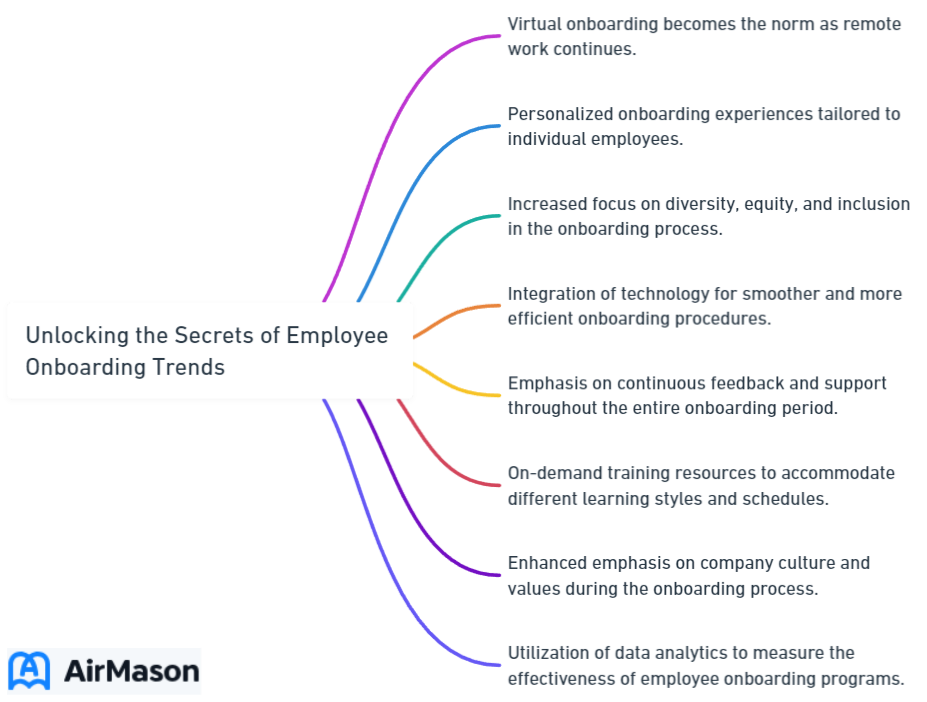
In today’s dynamic work environment, employee onboarding has become more crucial than ever. With the rise of remote work and the need for a diverse and inclusive workforce, companies must adapt and innovate to stay ahead of the curve. As we move further into 2024, it’s essential to examine the latest employee onboarding trends that will shape the future of work.
As we dive into the world of onboarding, you’ll discover how technology, personalization, and gamification are transforming the way new hires are welcomed into companies. You’ll also learn how diversity, equity, and inclusion (DEI) are being emphasized in onboarding to create a sense of belonging and acceptance for all employees.
Key Takeaways
- Onboarding has evolved to balance remote and hybrid work challenges, leveraging new technologies for communication and engagement.
- AI chatbots, machine learning, gamification & interactivity are revolutionizing the onboarding process with improved satisfaction & productivity.
- People analytics, employee surveys & design thinking principles can be used to create an enhanced onboarding experience.
The Evolution of Remote and Hybrid Onboarding
The shift towards remote and hybrid work has brought significant changes to the onboarding process. As companies adapt to the new normal, the onboarding experience has evolved to address the unique challenges and opportunities these work models present. The current employee onboarding trends of 2024 focus on finding the perfect balance between working remotely and fostering personal connections through virtual gatherings.
Remote onboarding poses challenges such as feelings of isolation and difficulty forming personal relationships with coworkers. However, it also offers numerous advantages like increased productivity, improved employee retention, and leveraging new technologies to foster personal connections and optimize HR efforts. To create a lasting impression on new hires, foster a positive work atmosphere, and attract top talent, it is necessary to adapt to these changes.
Managers should be actively involved in onboarding and discuss possibilities for progression. Pre-boarding activities may include:
- Poviding candidates with the initial steps of the onboarding process on a mobile device
- rDispatching company merchandise to their homes
- Sending inspirational text messages

Challenges and Solutions for Virtual Onboarding
Virtual onboarding can lead to a lack of peer-to-peer recognition and engagement with the company’s values among existing employees. To address these challenges, organizations can implement strategies like:
- Organizing virtual events focusing on employee appreciation
- Introducing a peer-to-peer recognition platform
- Promoting peer-to-peer recognition
- Utilizing points-based recognition
Companies like Phenom, Netflix, Zappos, Microsoft, and Onboard by HR Cloud have successfully implemented virtual employee onboarding solutions.
Enhanced communication during virtual onboarding relies heavily on technology. Employing the following tools can be beneficial in optimizing communication during virtual onboarding:
- Video conferencing software
- Onboarding software
- Collaborative communication tools
- Virtual reality (VR) technology
According to employee onboarding statistics, effective communication during onboarding can lead to increased employee engagement and retention.
Employee Onboarding: Setting the Foundation for Success
Employee onboarding is a crucial process that lays the groundwork for a successful and productive tenure within any organization. It encompasses the orientation and integration of new hires, providing them with the necessary tools, knowledge, and resources to seamlessly transition into their roles. Effective employee onboarding goes beyond just paperwork; it’s about instilling a sense of belonging and purpose in the organization. This process ensures that employees are not only equipped with the requisite skills but also aligned with the company’s values and culture. By investing in a robust onboarding program, businesses can significantly enhance retention rates and accelerate the time it takes for employees to become valuable contributors. Moreover, employee onboarding fosters a positive work environment, reinforcing the belief that each individual is a vital part of the collective success of the organization.
Streamlining Remote Onboarding with Technology
Digital onboarding solutions and AI chatbots, facilitated by technology, enhance the remote onboarding experience. A well-structured onboarding process can lead to better employee engagement and satisfaction. Digital onboarding solutions ensure a smooth onboarding process for organizations, while AI chatbots provide automated reminders, answer commonly asked questions, and inform new hires of any upcoming training sessions. These solutions align with current employee onboarding trends that focus on leveraging technology to improve the onboarding experience.
Streamlining and enhancing the onboarding process can be achieved through automation. To facilitate peer-to-peer learning during digital onboarding, companies can create interactive comment sections under training resources and dedicated Slack or Teams channels. By incorporating these strategies, organizations can effectively address virtual onboarding challenges and create a more engaging and enjoyable onboarding experience for new hires.
Emphasizing Diversity, Equity, and Inclusion in Onboarding

Onboarding trends in 2024 emphasize the importance of diversity, equity, and inclusion (DEI) in creating a welcoming and supportive environment for new hires. Incorporating diversity into onboarding processes can lead to organizations becoming more creative, efficient, and productive. Inclusive onboarding programs create an atmosphere of acceptance and belongingness for fresh hires, resulting in sustained productivity.
To incorporate DEI in the onboarding process, companies can:
- Emphasize diversity and inclusion during the onboarding experience
- Establish an onboarding mentorship program
- Maintain ongoing communication
- Include sessions on inclusion
- Share DE&I goals and company values
- Include diverse perspectives
- Make DE&I part of the onboarding curriculum
By embracing these strategies, organizations can demonstrate their commitment to DEI and foster a diverse and inclusive workplace culture.
DEI Training and Resources
DEI training and resources are incorporated into onboarding processes to foster a diverse and inclusive work environment. By integrating DEI training and resources into onboarding programs, companies can promote a diverse and inclusive environment for their employees.
Employees participate in diversity training, equity, and inclusion onboarding sessions, are connected to resources that illustrate the organization’s dedication to DEI, and are encouraged to bring their authentic selves to work. Cultivating a diverse and inclusive workplace, which can heighten employee engagement, optimize team dynamics, and enhance overall performance, relies on DEI training and resources.
Creating an Inclusive Environment for New Hires
Ensuring a welcoming environment for new hires necessitates personalized onboarding, mentorship programs, and a focus on long-term productivity. Organizations are implementing check-ins and mentor structures to promote acceptance and inclusivity among their new hires. Companies like Prezly encourage new employees to demonstrate their individual personalities by requesting they share a fun fact about themselves when they first join the company, which are then published on the company page.
Successful mentorship programs for new hires include Randstad’s Insider Program, Time Warner Cable’s employee mentorship program, and iGrow mentoring program. These programs provide new hires with valuable guidance and support to facilitate their integration into the company culture and enable their success in their roles.
Personalization and Customization in Employee Onboarding

Personalization and customization in employee onboarding have emerged as significant trends in 2024, enhancing the onboarding experience and boosting productivity. Research has indicated that 78% of employees have a positive attitude towards their employer when they have an onboarding program, and organizations with standard onboarding processes have seen a 50% boost in productivity.
Tailoring the company’s onboarding process to suit the individual needs of each new hire allows companies to ensure that onboarding employees feel welcomed, engaged, and capable of performing at their best. Implementing effective employee onboarding programs can significantly contribute to this goal, ultimately leading to increased job satisfaction.
Benefits of Personalized Onboarding
Personalized onboarding can result in heightened employee satisfaction, engagement, and retention. Personalized onboarding, which creates a sense of connection and belonging, sets clear expectations, provides relevant training and support, fosters a positive work culture, and reduces turnover, can contribute to increased employee engagement.
Strategies for Implementing Personalized Onboarding
To ensure a successful onboarding experience, companies should prioritize:
- Providing employees with the necessary information to succeed in their position
- Minimizing the amount of paperwork and processes
- Allocating more time to activities such as training, team building, and interactions with management
- Utilizing tailored workflows, custom guides, and individualized training to implement personalized onboarding.
Personalization in onboarding can include a film illustrating an employee’s day-to-day activities and a guide to achieving success within the organization. By incorporating these strategies, companies can create a more engaging and effective onboarding experience for their new hires.
What Are the 4 Phases of Onboarding
The 4 phases of onboarding encompass a structured approach to integrating new employees into an organization. The first phase, known as pre-boarding, begins before the official start date. During this period, necessary paperwork is completed, and initial introductions to the company culture may take place. The second phase, orientation, involves comprehensive familiarization with the organization’s policies, procedures, and the work environment. It often includes an introduction to key team members and an overview of the company’s mission and values. The third phase, job-specific training, hones in on the specific skills and knowledge required for the new role. This phase ensures that employees are well-equipped to perform their duties effectively. Finally, the fourth phase, ongoing integration, extends beyond the initial weeks or months and focuses on continuous support, feedback, and opportunities for growth, solidifying the new employee’s place within the organization. These four phases collectively create a robust onboarding process that sets the stage for a successful and productive employee tenure.
Leveraging Artificial Intelligence and Machine Learning in Onboarding

The world of employee onboarding is being transformed by artificial intelligence (AI) and machine learning through automation, chatbots, and enhanced training. These cutting-edge technologies are being utilized in employee onboarding to optimize the process and increase employee satisfaction and productivity.
As AI and machine learning continue to advance, their role in onboarding will only become more significant, shaping the future of how new hires are integrated into organizations.
AI Chatbots and Automation
AI chatbots can effectively streamline onboarding by providing automated reminders, responding to frequently asked questions, and monitoring employee sentiment. By sending notifications or reminders to new employees, AI chatbots can keep them informed and connected throughout the onboarding process.
In addition, AI chatbots can:
- Answer FAQs by generating a list of questions, training on the answers, utilizing natural language processing (NLP) algorithms, and offering immediate responses.
- Personalize the onboarding experience based on user responses.
- Utilize sentiment analysis and text analytics to monitor employee sentiment during onboarding, detecting potential issues, and measuring overall sentiment.
Machine Learning for Enhanced Training
Machine learning offers several advantages to employee onboarding, such as:
- AI-powered search
- Recommending applicants
- Analyzing feedback
- Account creation and access management
- AI-powered chatbots
By automating manual tasks and streamlining processes, machine learning can recognize patterns and trends in training data, allowing for tailored and targeted training recommendations for employees.
Companies like HireVue, IBM Watson, and Yelp have successfully incorporated machine learning into their onboarding process, improving their recruitment and onboarding processes, and enabling more effective and data-driven decision-making.
Gamification and Interactivity in Onboarding

Gamification and interactivity in onboarding are powerful ways to make the process more enjoyable and engaging for new hires. With the prevalence of remote work, creative onboarding processes like video-based and virtual onboarding are becoming increasingly popular, and gamification is a key component of these trends.
Incorporating game elements into the onboarding process allows companies to create an immersive and entertaining experience, fostering a positive corporate image and increased employee satisfaction.
Benefits of Gamified Onboarding
Gamified onboarding offers a range of benefits, including:
- Fostering a positive corporate image
- Providing instantaneous feedback
- Accelerating learning and acclimatization
- Motivating desired behaviors through positive reinforcements
- Enhancing employee retention and engagement
- Promoting a collaborative and inclusive corporate culture
- Offering rapid performance feedback and guidance
Gamified onboarding can lead to better outcomes in employee training by:
- Increasing engagement and motivation
- Providing an interactive and immersive learning experience
- Offering opportunities for skill practice and application
- Making the onboarding process more enjoyable.
Examples of Successful Gamified Onboarding
Successful examples of gamified onboarding include virtual reality (VR) training, scavenger hunts, and trivia events. VR training provides practical benefits to employee training and development in industries such as real estate, retail, tourism, and more, and companies like Accenture have achieved success in quickly onboarding new hires by distributing 60,000 headsets for employee training.
Scavenger hunts and trivia events are engaging onboarding activities that introduce new employees to the company culture and help them become acquainted with their new environment. By incorporating these gamified elements into the onboarding process, organizations can improve employee engagement and satisfaction.
Onboarding Employee Experience
The onboarding employee experience is a critical phase in any organization, setting the tone for an individual’s journey within the company. This process encompasses the formal introduction of new hires to the company’s culture, values, and operational procedures. A well-structured onboarding program not only familiarizes employees with their roles but also instills a sense of belonging and purpose. It provides them with the tools and knowledge necessary to navigate their responsibilities effectively. Additionally, a positive onboarding experience can significantly impact an employee’s job satisfaction and long-term commitment to the organization. By prioritizing the onboarding employee experience, companies demonstrate their dedication to nurturing a motivated and engaged workforce.
The Growing Importance of People Analytics in Onboarding

The growing role of people analytics in onboarding aids organizations in continuously improving and enhancing the employee experience. By utilizing data-driven insights, companies can optimize their onboarding process and increase employee satisfaction and productivity.
As 77% of HR professionals consider onboarding to be of increasing importance, incorporating people analytics into the onboarding process allows organizations to better understand and meet the needs of their new hires.
Using Employee Surveys for Continuous Improvement
Employee surveys are a valuable tool for collecting feedback from employees regarding their experience, engagement, and performance. This feedback can be used to refine the onboarding process and make employees more content and productive. Best practices for creating employee surveys include:
- Sending surveys at an appropriate time
- Keeping the surveys concise and straightforward
- Maintaining anonymity
- Involving teams and managers in the procedure
- Utilizing various question types
Design Thinking Principles for Enhanced Onboarding Experiences
Applying design thinking principles to onboarding can solve frustrations and deliver a more engaging experience. The core principles of design thinking in relation to employee onboarding involve prioritizing empathy, adopting a human-centric perspective, and iterating through the process.
By gaining insights into the pain points, needs, and challenges of employees and creating a workplace that improves the onboarding experience, design thinking can lead to more effective and engaging onboarding processes.
Summary
In conclusion, the employee onboarding trends of 2024 emphasize the importance of remote and hybrid onboarding, DEI, personalization, AI and machine learning, gamification, and people analytics. By adapting to these trends and leveraging the latest technologies and strategies, organizations can create more engaging, inclusive, and effective onboarding experiences for their new hires.
As we move forward in an ever-evolving world of work, companies must continue to innovate and adapt their onboarding processes to meet the needs of their employees. By creating a welcoming and supportive environment for new hires, organizations can ensure long-lasting success and a more engaged and satisfied workforce.
Frequently Asked Questions
What are the trends for onboarding in 2024?
2024 is likely to bring continued virtual, personalized, and technology-enabled onboarding experiences for new hires, allowing companies to better facilitate their success.
What are the 5 C’s of onboarding?
The 5 “C’s” of effective onboarding are compliance, clarification, confidence, connection, and culture, providing a comprehensive framework to ensure new employees have the best possible start.
What are the 4 C’s of effective onboarding?
The 4 C’s of onboarding are critical to ensure successful integration of new hires into an organization. They include compliance, clarification, culture, and connection – all essential to creating a positive onboarding experience.
What is Phase 4 of onboarding?
Phase 4 of onboarding is the transition period to move from a new employee to becoming a full-fledged team member, assisting the new hire in this shift.
What are the main challenges of remote onboarding?
Remote onboarding can be challenging as it leads to feelings of isolation and difficulty building relationships with colleagues. This can make the process of being brought on board less effective and could lead to decreased productivity.